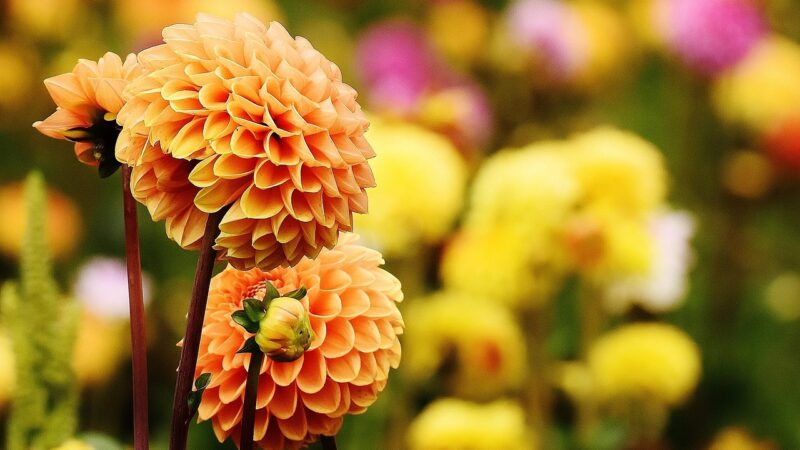The wintering of the dahlia

The process of successfully overwintering dahlias is a crucial skill for gardeners in climates where the ground freezes, as the tender tubers cannot survive such conditions. This annual ritual of lifting, preparing, and storing the tubers ensures the preservation of your favorite varieties for the following season. While it may seem like a daunting task, with a clear understanding of the steps involved—from knowing the right time to dig, to proper curing and storage techniques—it becomes a manageable and rewarding part of the dahlia-growing cycle. Proper winter care is the bridge between one glorious season of blooms and the next, safeguarding your horticultural investment and the promise of future beauty.
Knowing when to lift the tubers
The timing for lifting dahlia tubers from the ground is a critical decision that significantly impacts their long-term viability. The process is dictated not by the calendar, but by the weather. The ideal time to dig up the tubers is after the first hard frost of the autumn has blackened the plant’s foliage. This frost event is an essential natural signal that tells the plant to stop its active growth and enter a state of dormancy. It triggers the plant to draw down the remaining energy from its stems and leaves and consolidate it within the tuber for winter storage.
It is important not to be too hasty in either cutting down the plant or digging it up immediately after the frost. For optimal tuber development and maturity, it is best to leave the tubers in the ground for one to two weeks after the foliage has been killed back. This waiting period allows the skin of the tubers to thicken and cure, which makes them more resilient and less prone to damage during the lifting and handling process. A tougher skin also provides better protection against moisture loss and rot during the months they will spend in storage.
Before you are ready to lift, the first step is to cut back the blackened stalks. Using a sharp pair of loppers or pruners, cut the main stems down to a height of about 4 to 6 inches. This remaining portion of the stalk serves a dual purpose: it provides a convenient handle to help you gently lift the heavy clump from the soil, and it is a perfect place to securely attach a label with the variety name, ensuring you can identify your dahlias come springtime. Accurate labeling is crucial, especially if you grow multiple varieties.
In regions with very mild winters where the ground does not freeze (typically USDA zones 8 and above), gardeners have the option of leaving the tubers in the ground to overwinter. However, this method comes with risks, as a particularly cold or wet winter can still lead to the tubers freezing or rotting. If you choose this method, you must provide a thick layer of insulation over the dormant plants. After cutting down the stalks, cover the area with a deep mulch, at least 10-12 inches, of a material like straw, shredded leaves, or bark chips to protect the tubers from temperature fluctuations and excess moisture.
More articles on this topic
The process of lifting and curing
Once the waiting period after the first frost is over and the stalks have been cut back, it is time to carefully lift the dahlia tuber clumps from the ground. This task requires a gentle touch to avoid damaging the delicate tubers. Begin by using a garden fork or a spade to loosen the soil in a wide circle around the base of the plant, about a foot away from the central stalk. This precaution helps to minimize the risk of accidentally spearing or breaking the tubers. Work your way around the plant, gently prying upwards to loosen the entire clump from the soil.
Once the soil is loosened, place your fork underneath the main root ball and carefully lift the entire clump out of the ground. Try to support the weight of the clump from below to prevent the individual tubers from snapping off at their narrow necks, which is the most vulnerable point. A broken neck disconnects the tuber from the crown, and since the growing eyes are located on the crown, a tuber without a neck connection is useless and will not grow. Handle the freshly dug clump with the same care you would handle a bag of potatoes.
After lifting, the next step is to clean the tubers. Gently remove the large clods of soil by hand. While some gardeners prefer to wash the tubers with a hose to remove all the soil, others prefer a ‘dry clean’ method, simply brushing off the excess dirt after the clump has had a chance to dry slightly. Washing can introduce excess moisture, which can increase the risk of rot in storage if the tubers are not dried thoroughly. If you do choose to wash them, be sure to do so gently and allow them to dry completely in a well-ventilated, frost-free location for several days before storing.
Curing is the final and most important step before storage. This process allows the skin of the tubers to toughen and helps any minor cuts or scrapes to heal and callus over, which seals them off from potential diseases. Place the cleaned tuber clumps upside down in a cool, dry, and airy location that is protected from frost, such as a garage, shed, or basement. Leaving them upside down helps any excess moisture to drain out of the hollow stalks. The curing process typically takes one to two weeks, after which the tubers are ready to be prepared for their long winter rest.
More articles on this topic
Methods for successful storage
Choosing the right storage method is key to ensuring your dahlia tubers survive the winter and are in prime condition for planting in the spring. The ideal storage environment is one that is cool, dark, and has a moderate level of humidity—essentially mimicking the conditions of a traditional root cellar. The goal is to keep the tubers dormant without letting them either dry out and shrivel or become too damp and rot. A temperature range of 4 to 10 degrees Celsius (40 to 50 degrees Fahrenheit) is considered optimal. A location that is too warm will encourage the tubers to sprout prematurely, while a location that freezes will kill them.
One of the most popular and effective methods for storing dahlia tubers is to pack them in a medium that helps to regulate moisture levels. You can use materials like slightly dampened peat moss, sand, vermiculite, or wood shavings (pet bedding works well). Place a layer of your chosen medium in the bottom of a container, such as a cardboard box, a plastic bin with ventilation holes, or a wooden crate. Arrange the dahlia clumps or individual tubers on this layer, ensuring they are not touching each other, and then cover them completely with more of the medium.
Another common technique is the wrapping method. Each individual tuber or small clump can be wrapped in several sheets of newspaper and placed in a box. The newspaper acts as insulation and helps to wick away any excess moisture while preventing the tubers from drying out too quickly. This method can be a bit more time-consuming, but it is very effective at isolating the tubers from one another, which means that if one tuber happens to start rotting, it is less likely to spread to the others in the container.
For gardeners with a large number of tubers, the plastic wrap method has gained popularity. After the tubers are cleaned and cured, each clump or individual tuber is tightly wrapped in several layers of plastic kitchen wrap. This creates a microenvironment that traps the tuber’s own moisture, preventing it from shriveling while also protecting it from external moisture that could cause rot. The wrapped tubers can then be placed in boxes and stored in a cool, dark location. This method is space-efficient and allows for easy inspection of the tubers throughout the winter.
Winter care and inspection
Once your dahlia tubers are packed away for the winter using your chosen storage method, your job is not quite finished. It is important to check on them periodically throughout their dormancy to catch any potential problems early. Plan to inspect your stored tubers at least once a month. This regular check-in allows you to assess their condition and make any necessary adjustments to their storage environment. An issue that is caught in December can be corrected, but an issue that is left unchecked until March may result in the loss of your entire stock.
During your monthly inspection, you will be looking for two main problems: shriveling and rot. Gently unwrap or uncover a few tubers from different parts of your storage container to check their condition. If the tubers appear wrinkled and shriveled, it is a sign that the storage environment is too dry and they are losing too much moisture. To remedy this, you can lightly mist the storage medium (like peat moss or wood shavings) with a spray bottle of water to reintroduce a small amount of humidity. If you used the wrapping method, you may need to move them to a slightly cooler, more humid location.
Conversely, if you find tubers that are soft, mushy, or show signs of fuzzy mold, the storage environment is too damp. This is the more serious of the two problems, as rot can spread quickly. Immediately remove and discard any tubers that are showing signs of decay to prevent them from affecting the healthy ones. The remaining healthy tubers should be allowed to air dry for a day or so before being repacked in fresh, completely dry storage medium. You may also need to improve the ventilation in your storage area or move the tubers to a drier location.
As late winter approaches, you may notice that some of your tubers are beginning to show signs of life by developing small sprouts or ‘eyes’. This is a normal occurrence, especially if your storage location has warmed up slightly, and it is a good sign that the tubers are viable and ready for the upcoming growing season. As long as the sprouts are small and compact, there is no need for concern. Simply handle the tubers carefully to avoid breaking them off. These periodic checks ensure that you can address any issues promptly, maximizing the number of healthy, viable tubers that make it through to spring planting time.


















